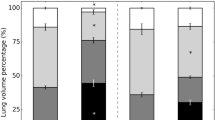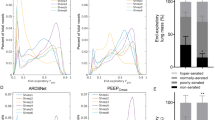Abstract
Image Functional Modeling (IFM) synthesizes three dimensional airway networks with imaging and mechanics data to relate structure to function. The goal of this study was to advance IFM to establish a method of exploring how heterogeneous alveolar flooding and collapse during lung injury would impact regional respiratory mechanics and flow distributions within the lung at distinct positive end-expiratory pressure (PEEP) levels. We estimated regional respiratory system elastance from computed tomography (CT) scans taken in 5 saline-lavaged sheep at PEEP levels from 7.5 to 20 cmH2O. These data were anatomically mapped into a computational sheep lung model, which was used to predict the corresponding impact of PEEP on dynamic flow distribution. Under pre-injury conditions and during lung injury, respiratory system elastance was determined to be spatially heterogeneous and the values were distributed with a hyperbolic distribution in the range of measured values. Increases in PEEP appear to modulate the heterogeneity of the flow distribution throughout the injured lung. Moderate increases in PEEP decreased the heterogeneity of elastance and predicted flow distribution, although heterogeneity began to increase for PEEP levels above 12.5–15 cmH2O. By combining regional respiratory system elastance estimated from CT with our computational lung model, we can potentially predict the dynamic distribution of the tidal volume during mechanical ventilation and thus identify specific areas of the lung at risk of being overdistended.








Similar content being viewed by others
Abbreviations
- C ROI :
-
respiratory system compliance of a region of interest
- Cg i :
-
acinar gas compression compliance
- CT:
-
computed tomography
- E low :
-
low frequency respiratory system elastance
- E ROI :
-
respiratory system elastance of a region of interest
- E rs :
-
respiratory system elastance
- G i :
-
tissue damping factor of the ith acini
- H i :
-
tissue elastance of the ith acini
- i :
-
index for acini in model
- IFM:
-
Image Functional Modeling
- k :
-
index for consecutive PEEP levels
- N acini :
-
total number of acini
- N ROI :
-
number of acini within a region of interest
- P atm :
-
atmospheric pressure
- PEEP:
-
positive end-expiratory level
- ROI:
-
region of Interest
- R het :
-
absolute difference between low and high frequency respiratory system resistance
- R rs :
-
respiratory system resistance
- sE ROI :
-
specific respiratory system elastance of a region of interest
- V i :
-
acinar volume
- \( {\mathop V\limits^ \bullet }_{{{\text{in}}}} \) :
-
input flow of unit amplitude and known frequency
- V ROI :
-
air volume of a region of interest
- \( {\mathop V\limits^ \bullet }^{{{\text{actual}}}}_{i} \) :
-
actual acinar flow
- \( {\mathop V\limits^ \bullet }^{{{\text{equal}}}}_{i} \) :
-
acinar flow in homogeneous properties and a symmetrical tree
- \( {\mathop V\limits^ \bullet }^{{{\text{Normalized}}}}_{i} \) :
-
normalized acinar flow
- Z i :
-
acinar mechanical impedance
- Zt i :
-
acinar tissue impedance of the ith acini
- η :
-
tissue hysteresivity
- ω :
-
angular frequency
References
Amato M. B., C. S. Barbas, D. M. Medeiros, R. B. Magaldi, G. P. Schettino, G. Lorenzi-Filho, R. A. Kairalla, D. Deheinzelin, C. Munoz, R. Oliveira, T. Y. Takagaki, C. R. Carvalho. Effect of a protective-ventilation strategy on mortality in the acute respiratory distress syndrome. N Engl J Med 338:347, 1998.
Bellardine Black C. L., A. M. Hoffman, L. W. Tsai, E. P. Ingenito, B. Suki, D. W. Kaczka, B. A. Simon, K. R. Lutchen. Relationship between dynamic respiratory mechanics and disease heterogeneity in sheep lavage injury. Crit Care Med 35:870, 2007.
Bellardine C. L., E. P. Ingenito, A. Hoffman, F. Lopez, W. Sanborn, B. Suki, K. R. Lutchen. Heterogeneous airway versus tissue mechanics and their relation to gas exchange function during mechanical ventilation. Ann Biomed Eng 33:626, 2005.
Betke M., H. Hong, D. Thomas, C. Prince, J. P. Ko. Landmark detection in the chest and registration of lung surfaces with an application to nodule registration. Med Image Anal 7:265, 2003.
Brower R. G., A. Morris, N. MacIntyre, M. A. Matthay, D. Hayden, T. Thompson, T. Clemmer, P. N. Lanken, D. Schoenfeld. Effects of recruitment maneuvers in patients with acute lung injury and acute respiratory distress syndrome ventilated with high positive end-expiratory pressure. Crit Care Med 31:2592, 2003.
East T. D., J. C. in’t Veen, T. A. Jonker, N. L. Pace, S. McJames. Computer-controlled positive end-expiratory pressure titration for effective oxygenation without frequent blood gases. Crit Care Med 16:252, 1988.
Gattinoni L., A. Pesenti, L. Avalli, F. Rossi, M. Bombino. Pressure-volume curve of total respiratory system in acute respiratory failure. Computed tomographic scan study. Am Rev Respir Dis 136:730, 1987.
Gillis H. L., K. R. Lutchen. How heterogeneous bronchoconstriction affects ventilation distribution in human lungs: a morphometric model. Ann Biomed Eng 27:14, 1999.
Halter J. M., J. M. Steinberg, H. J. Schiller, M. DaSilva, L. A. Gatto, S. Landas, G. F. Nieman. Positive end-expiratory pressure after a recruitment maneuver prevents both alveolar collapse and recruitment/derecruitment. Am J Respir Crit Care Med 167:1620, 2003.
Hantos Z., B. Daroczy, B. Suki, S. Nagy, J. J. Fredberg. Input impedance and peripheral inhomogeneity of dog lungs. J Appl Physiol 72:168, 1992.
Henderson A. C., E. P. Ingenito, H. Atileh, E. Israel, B. Suki, K. R. Lutchen. How does airway inflammation modulate asthmatic airway constriction? An antigen challenge study. J Appl Physiol 95:873, 2003.
Hoffman E. A., J. M. Reinhardt, M. Sonka, B. A. Simon, J. Guo, O. Saba, D. Chon, S. Samrah, H. Shikata, J. Tschirren, K. Palagyi, K. C. Beck, G. McLennan. Characterization of the interstitial lung diseases via density-based and texture-based analysis of computed tomography images of lung structure and function. Acad Radiol 10:1104, 2003.
Ito S., E. P. Ingenito, S. P. Arold, H. Parameswaran, N. T. Tgavalekos, K. R. Lutchen, B. Suki. Tissue heterogeneity in the mouse lung: effects of elastase treatment. J Appl Physiol 97:204, 2004.
Kaczka D. W., D. N. Hager, M. L. Hawley, B. A. Simon. Quantifying mechanical heterogeneity in canine acute lung injury: impact of mean airway pressure. Anesthesiology 103:306, 2005.
Kaczka D. W., E. P. Ingenito, S. C. Body, S. E. Duffy, S. J. Mentzer, M. M. DeCamp, K. R. Lutchen. Inspiratory lung impedance in COPD: effects of PEEP and immediate impact of lung volume reduction surgery. J Appl Physiol 90:1833, 2001.
Kaczka D. W., E. P. Ingenito, K. R. Lutchen. Technique to determine inspiratory impedance during mechanical ventilation: implications for flow limited patients. Ann Biomed Eng 27:340, 1999.
Kaczka, D. W., C. B. Massa, and B. A. Simon. Reliability of estimating stochastic lung tissue heterogeneity from pulmonary impedance spectra: A forward-inverse modeling study. Ann. Biomed. Eng., 2007.
Li B., G. E. Christensen, E. A. Hoffman, G. McLennan, J. M. Reinhardt. Establishing a normative atlas of the human lung: intersubject warping and registration of volumetric CT images. Acad Radiol 10:255, 2003.
Lutchen K. R., H. Gillis. Relationship between heterogeneous changes in airway morphometry and lung resistance and elastance. J Appl Physiol 83:1192, 1997.
Lutchen K. R., A. Jensen, H. Atileh, D. W. Kaczka, E. Israel, B. Suki, E. P. Ingenito. Airway constriction pattern is a central component of asthma severity: the role of deep inspirations. Am J Respir Crit Care Med 164:207, 2001.
Matsopoulos G. K., N. A. Mouravliansky, P. A. Asvestas, K. K. Delibasis, V. Kouloulias. Thoracic non-rigid registration combining self-organizing maps and radial basis functions. Med Image Anal 9:237, 2005.
Maunder R. J., W. P. Shuman, J. W. McHugh, S. I. Marglin, J. Butler. Preservation of normal lung regions in the adult respiratory distress syndrome. Analysis by computed tomography. Jama 255:2463, 1986.
Otis A. B., C. B. McKerrow, R. A. Bartlett, J. Mead, M. B. McIlroy, N. J. Selver-Stone, E. P. Radford Jr. Mechanical factors in distribution of pulmonary ventilation. J Appl Physiol 8:427, 1956.
Sakai H., E. P. Ingenito, R. Mora, S. Abbay, F. S. Cavalcante, K. R. Lutchen, B. Suki. Hysteresivity of the lung and tissue strip in the normal rat: effects of heterogeneities. J Appl Physiol 91:737, 2001.
Tawhai M. H., K. S. Burrowes. Developing integrative computational models of pulmonary structure. Anat Rec B New Anat 275:207, 2003.
Tawhai M. H., P. Hunter, J. Tschirren, J. Reinhardt, G. McLennan, E. A. Hoffman. CT-based geometry analysis and finite element models of the human and ovine bronchial tree. J Appl Physiol 97:2310, 2004.
Tgavalekos, N. T., M. Tawhai, R. S. Harris, J. G. Venegas, and K. R. Lutchen. Identifying airways responsible for heterogeneous ventilation and mechanical dysfunction in asthma: An image-functional modeling approach. J. Appl. Physiol., 2005.
Tgavalekos N. T., J. G. Venegas, B. Suki, K. R. Lutchen. Relation between structure, function, and imaging in a three-dimensional model of the lung. Ann Biomed Eng 31:363, 2003.
Ventilation with lower tidal volumes as compared with traditional tidal volumes for acute lung injury and the acute respiratory distress syndrome. The Acute Respiratory Distress Syndrome Network. N. Engl. J. Med. 342:1301, 2000.
Vieira S. R., L. Puybasset, Q. Lu, J. Richecoeur, P. Cluzel, P. Coriat, J. J. Rouby. A scanographic assessment of pulmonary morphology in acute lung injury. Significance of the lower inflection point detected on the lung pressure-volume curve. Am J Respir Crit Care Med 159:1612, 1999.
Acknowledgments
This work was supported by the National Science Foundation BES-0114538, the National Institutes of Health HL62269-04, the National Institutes of Health HL-073994, The Association for Women in Science, and The Foundation for Anesthesia Education and Research. Additionally, Puritan Bennett/Tyco Healthcare provided the NPB840 used in the experiments.
Author information
Authors and Affiliations
Corresponding author
Rights and permissions
About this article
Cite this article
Bellardine Black, C.L., Hoffman, A.M., Tsai, L.W. et al. Impact of Positive End-Expiratory Pressure During Heterogeneous Lung Injury: Insights from Computed Tomographic Image Functional Modeling. Ann Biomed Eng 36, 980–991 (2008). https://doi.org/10.1007/s10439-008-9451-x
Received:
Accepted:
Published:
Issue Date:
DOI: https://doi.org/10.1007/s10439-008-9451-x




